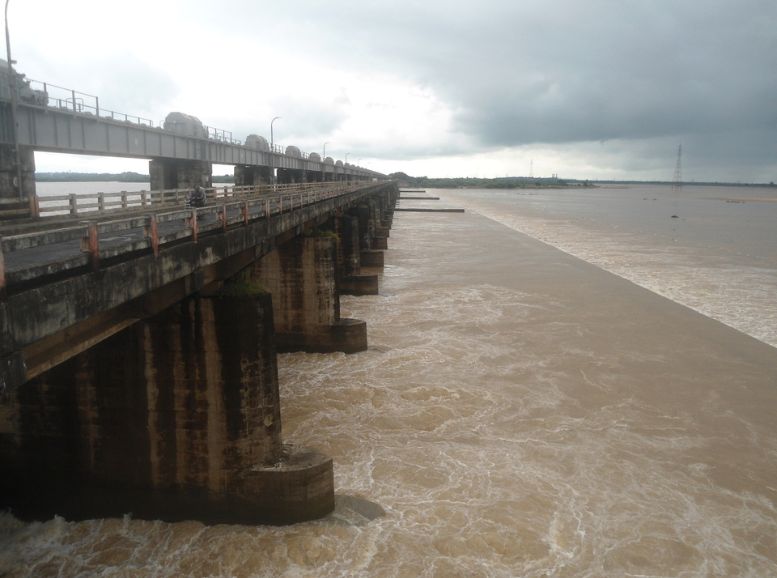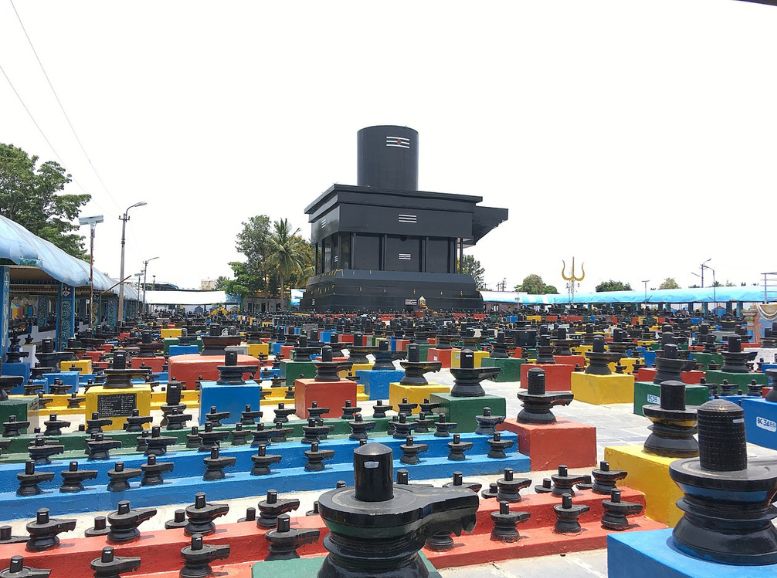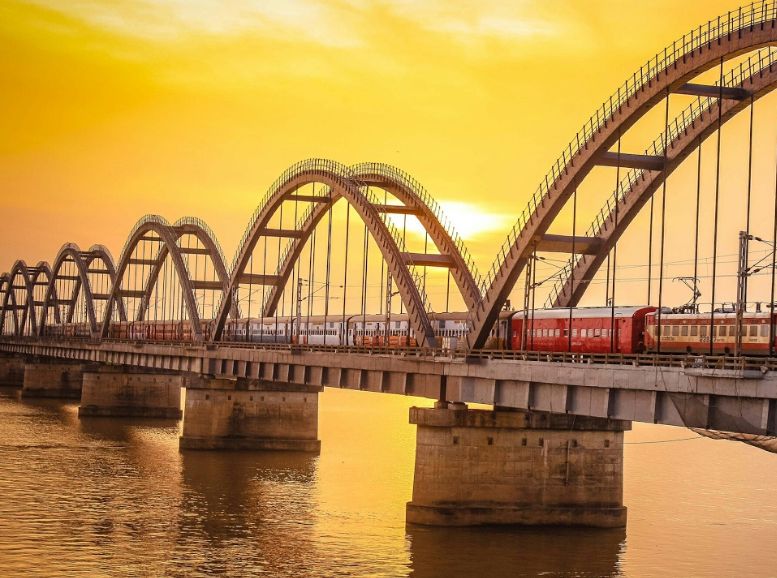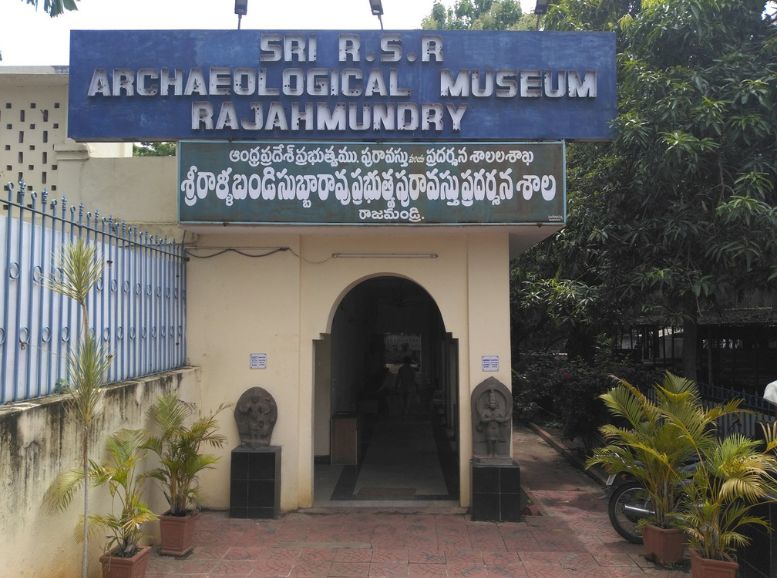Rajahmundry, cradled by the sacred Godavari River, embodies the very essence of Andhra Pradesh’s cultural tapestry and breathtaking beauty. Steeped in a rich history, adorned with architectural wonders, and blessed with captivating landscapes, this vibrant city beckons travelers yearning for an authentic South Indian experience.
This travelogue invites you on a captivating exploration of Rajahmundry, where ancient traditions intertwine with modern life, and every corner whispers tales of a bygone era. Whether you’re an adventurous explorer, a history buff, or simply a soul seeking serenity, Rajahmundry promises an unforgettable adventure.
How to reach:
By Air:
Rajahmundry boasts its own domestic airport, Rajahmundry Airport (IATA: RJA), situated roughly 18 kilometers from the city center. This convenient gateway welcomes both domestic and international travelers seeking to connect with major Indian cities via regular flights offered by several airlines.
By Train:
Rajahmundry Junction Railway Station serves as a key railway hub in Andhra Pradesh. Located in the heart of the city, it offers seamless access for train travelers. Regular services connect Rajahmundry to prominent destinations like Hyderabad, Chennai, Kolkata, Bangalore, and beyond.
By Road:
Rajahmundry’s well-developed road network makes it easily accessible by road. National Highway 16 (NH16) traverses the city, providing connections to Vijayawada, Visakhapatnam, Kolkata, and other destinations. State-run buses, private coaches, and taxis ensure a smooth journey for travelers arriving by road.
Best time to visit:
Winter (October – February):
Arguably the crown jewel of Rajahmundry’s seasons, winter offers pleasant and comfortable weather (15°C to 30°C) for exploring the outdoors. Perfect for sightseeing, temple visits, and serene boat rides on the Godavari River, winter’s dry and mild climate makes it ideal for experiencing all the city has to offer. The vibrant tapestry of winter is further enriched by festivals like Sankranti (January) and Maha Shivaratri (February), adding a touch of cultural magic to your visit.
Spring (March – May):
Spring whispers the arrival of summer, with temperatures gradually rising and occasional warm days. While the heat may increase slightly, this season boasts stunning natural beauty as trees burst into colorful blooms and the countryside awakens. Spring remains a viable option for exploring Rajahmundry’s treasures and enjoying outdoor activities like boating and sightseeing, especially if you’re comfortable with warmer weather.
Monsoon (June – September):
The monsoon brings a welcome respite from the summer’s scorching heat, gracing Rajahmundry with moderate to heavy rainfall. While the lush landscapes and rejuvenated rivers create a picture-perfect backdrop, navigating the monsoon can be challenging due to occasional showers and high humidity. However, for nature enthusiasts who relish the ethereal beauty of rain-washed surroundings, the monsoon offers a unique and tranquil experience.
Summer(March – May):
Summer in Rajahmundry is characterized by hot and humid weather, with temperatures often exceeding 35°C. The intense heat makes outdoor exploration uncomfortable, and dehydration and sunburn become potential concerns. While summer may not be the most popular time to visit, it presents an opportunity to delve into indoor attractions like museums, art galleries, and captivating cultural performances.
Attractions:
Dowleswaram Barrage:

A testament to human innovation, the Dowleswaram Barrage near Rajahmundry stands as a marvel of engineering, regulating the flow of the mighty Godavari River. As you ascend this iconic structure, the river’s rhythmic pulse captivates your senses, while breathtaking panoramic vistas unfold before your eyes. Beyond its role as a life-giving source of irrigation for the region, the barrage offers a haven of tranquility for visitors seeking refuge from the urban clamor.
Kotilingeswara Temple:

On the sacred banks of the Godavari River, the Kotilingeswara Temple reigns as a beacon of spirituality and devotion in Rajahmundry. Dedicated to Lord Shiva, this ancient edifice boasts exquisite architecture, intricate carvings, and hallowed sanctums that reverberate with the chants of pilgrims. As you step through the temple gates, a wave of peace and tranquility washes over you, transporting you to a realm of divine serenity.
The temple’s heart lies in its multitude of lingams, each symbolizing the ever-present essence of Lord Shiva and igniting a deep sense of reverence among devotees. Witnessing the rituals and ceremonies meticulously performed by the priests further amplifies the temple’s spiritual aura. Here, in this sacred sanctum sanctorum, the devout seek solace and blessings from the divine.
Rajahmundry Bridge:

A symbol of architectural and engineering marvel, the Rajahmundry Bridge, also known as the Godavari Arch Bridge, stretches majestically across the Godavari River. As you journey across this iconic landmark, breathtaking panoramic views unfold before your eyes. The mighty river, the vibrant cityscape, and the verdant landscapes around it combine to create a mesmerizing spectacle of nature’s grandeur.
Whether you choose to walk, drive, or cycle across the bridge, the experience is exhilarating. Witness the seamless integration of human ingenuity with the river’s natural beauty.
Rallabandi Subbarao Government Museum:

Embark on a captivating journey through time at the Rallabandi Subbarao Government Museum in Rajahmundry. Nestled within a sprawling complex, this museum serves as a treasure trove of Andhra Pradesh’s cultural heritage. Here, a diverse collection of artifacts, sculptures, and historical exhibits awaits, offering a window into the region’s illustrious past.
From ancient relics whispering tales of bygone eras to archaeological finds unearthing civilizations long lost, the museum offers a comprehensive exploration. Ethnographic displays showcase the region’s unique traditions, while contemporary artworks breathe life into the present. Each gallery unveils a captivating chapter in Andhra Pradesh’s art, history, and way of life.
Local Experiences:
Witness the Magic of Pochampalli Saree Weaving:
- Explore the captivating world of Pochampalli sarees, renowned for their intricate geometric designs and vibrant colors.
- Embark on a guided tour of a local weaving unit and witness the remarkable skill and dedication of artisans as they bring these beautiful sarees to life on traditional looms.
- Under the patient guidance of experienced weavers, even try your hand at weaving, gaining a newfound appreciation for the meticulous craftsmanship behind each saree.
Immerse Yourself in the Grace of Kuchipudi Dance:
- Experience the captivating grace and elegance of Kuchipudi, a classical dance form that originated in Andhra Pradesh.
- Witness a live performance by talented local dancers and be mesmerized by the expressive gestures, rhythmic footwork, and elaborate costumes that bring Hindu mythology to life through captivating storytelling in dance.
Explore the Bustling Night Markets:
- Lose yourself in the vibrant energy of Rajahmundry’s bustling night markets, teeming with colorful stalls overflowing with local produce, handcrafted souvenirs, and enticing street food vendors.
- Savor the delightful flavors of freshly prepared local delicacies like mirchi bajji (spicy fritters), punugulu (deep-fried rice balls), and crispy dosas, all bursting with authentic Andhra spices.
- Engage with friendly locals, try your bargaining skills to find unique souvenirs, and soak in the lively atmosphere that characterizes Rajahmundry’s night scene.
Unleash Your Inner Chef in a Cooking Class:
- Delve into the aromatic world of Andhra cuisine by participating in a hands-on cooking class led by a local chef.
- Learn the secrets behind traditional dishes, using fresh, locally sourced ingredients and a symphony of aromatic spices that are the soul of Andhra cooking.
- Enjoy the camaraderie as you cook alongside fellow travelers, share stories, and savor a delicious homemade meal, a testament to your newfound culinary skills.
Embark on a Historical Journey Through Old Rajahmundry:
- Join a guided heritage walk through the charming lanes of Old Rajahmundry and discover the city’s rich tapestry of history and culture.
- Explore centuries-old temples that stand as testaments to the region’s faith, marvel at the ornate architecture of ancient mansions, and gain insights into the colonial era through heritage buildings, each whispering tales of a bygone time.
- Listen to captivating stories and anecdotes shared by knowledgeable guides, bringing the city’s cultural heritage to life in a way that guidebooks simply cannot.
Travel tips:
- Plan Ahead: Research and create your itinerary before arriving to maximize your time in Rajahmundry.
- Check the Forecast: Especially during monsoons, keep an eye on the weather and pack accordingly.
- Local Customs: Familiarize yourself with local customs and traditions to show respect for Rajahmundry’s culture.
- Hydration is Key: Rajahmundry can get hot, so drink plenty of water throughout your visit, especially during summers.
- Dress Modestly: When visiting temples and religious sites, dress modestly and remove footwear before entering.
- Sun Safety: Protect yourself with sunscreen, a hat, and sunglasses, particularly for outdoor activities.
- Bargaining Tips: While shopping at local markets, feel free to bargain respectfully for better prices.
- Savor Local Flavors: Indulge in Andhra Pradesh’s cuisine by trying delicious biryani, dosas, and traditional sweets.
- Be Aware: Stay mindful of your surroundings and keep your belongings secure, especially in crowded areas.
- Reliable Transport: Opt for reputable transportation like taxis or authorized tour operators for a safe and comfortable journey.
- Wildlife Respect: When exploring natural areas like Papi Hills, follow park rules to protect wildlife and the environment.
- Keep in Touch: Inform loved ones of your whereabouts and use your phone or other devices to stay connected.
- Basic Telugu Phrases: Learn a few basic phrases in Telugu, the local language, to communicate and show appreciation for the culture.
- Emergency Numbers: Save important numbers like local emergency services and your embassy’s contact information for emergencies.
- Leave No Trace: Practice responsible tourism by disposing of waste properly and leaving natural and cultural sites pristine.
Conclusion
Farewell, Rajahmundry! This vibrant city on the Godavari River transcends the ordinary, leaving an indelible mark long after your departure. Every corner, from the Godavari’s tranquil embrace to the Rajahmundry Bridge’s majestic sweep, whispers tales of heritage, tradition, and unwavering spirit. Rajahmundry offers a captivating tapestry of experiences – serene river cruises, ancient temples to explore, and delectable Andhra cuisine to tantalize your taste buds. Time gracefully slows here, inviting you to fully immerse yourself in the beauty of nature, the warmth of local hospitality, and the richness of cultural heritage. As you depart, cherish the memories: moments shared with welcoming locals, the explosion of flavors on your palate, and the captivating sights forever etched in your mind. Plan your unforgettable escape using our comprehensive travel guide on Xploro.com We’ll guide you through everything you need to know, ensuring your Rajahmundry experience is as enriching and delightful as it deserves to be.
FAQs
- How can I get Rajahmundry?
- Rajahmundry is accessible via multiple modes of transportation. You can reach the city by air through Rajahmundry Airport, by train via Rajahmundry Junction Railway Station, or by road using national highways such as NH16.
- What are the top attractions in Rajahmundry?
- Rajahmundry boasts several captivating attractions, including the Godavari River Cruise, Papi Hills, Dowleswaram Barrage, Kotilingeswara Temple, ISKCON Temple, Rajahmundry Bridge, and Rallabandi Subbarao Government Museum.
- What are some experiences to try in Rajahmundry?
- Visitors can immerse themselves in local culture by visiting a Pochampalli Saree Weaving Unit, attending Kuchipudi Dance Performances, exploring the night markets, participating in cooking classes, and enjoying heritage walks through Old Rajahmundry.
- What should I pack for my trip to Rajahmundry?
- Essential items to pack for a trip to Rajahmundry include lightweight clothing, comfortable footwear, sunscreen, a hat, sunglasses, insect repellent, and any necessary medications.
- Is it safe to travel alone in Rajahmundry?
- While Rajahmundry is generally safe for solo travelers, it’s advisable to exercise caution, especially at night and in crowded areas. Stay vigilant and keep belongings secure to minimize risks.
- What is the currency accepted in Rajahmundry?
- The currency used in Rajahmundry is the Indian Rupee (INR). Credit and debit cards are widely accepted in most establishments, but it’s recommended to carry cash for smaller transactions and in remote areas.
- What are some popular dishes to try in Rajahmundry?
- Rajahmundry offers a delightful culinary experience with dishes like Pesarattu, Gongura Pachadi, Bamboo Chicken, Biryani, and traditional sweets such as Ariselu and Pootharekulu.
- Are there any festivals celebrated in Rajahmundry?
- Yes, Rajahmundry celebrates various festivals throughout the year, including Sankranti, Maha Shivaratri, Ugadi, and Diwali, offering visitors an opportunity to immerse themselves in local culture and traditions.
- Are there any eco-friendly activities in Rajahmundry?
- Visitors can engage in eco-friendly activities like birdwatching, nature walks, and exploring the scenic beauty of Papi Hills. Responsible tourism practices are encouraged to preserve the region’s natural resources.
- What are some family-friendly attractions in Rajahmundry?
- Family-friendly attractions in Rajahmundry include boat rides on the Godavari River, visits to the ISKCON Temple, exploring the Rallabandi Subbarao Government Museum, and enjoying picnics at scenic spots like Pushkar Ghat.
- Is English widely spoken in Rajahmundry?
- While Telugu is the primary language, English is also commonly understood, particularly in tourist areas, hotels, and restaurants. Basic English phrases will suffice for communication with locals.



